University of South Australia: INFS 5024 Enterprise Systems SAP Report
VerifiedAdded on 2022/09/18
|10
|1979
|21
Report
AI Summary
This report provides a comprehensive analysis of Enterprise Systems using SAP, beginning with an overview of a typical manufacturing company and its functional areas such as Human Resources, Production, Accounting and Finance, Marketing and Operations. It then explores how Enterprise Resource Planning (ERP) systems enhance productivity and efficiency by integrating business processes, reducing waste, improving operations, and fostering collaboration. The report then delves into a case study of Woolworths Group Limited, a major retail company, examining the challenges and benefits of implementing ERP systems, including issues with documentation, intellectual property, and resource projection. Furthermore, the report discusses the advantages of applying business intelligence, combined with ERP, for faster financial reporting, improved data quality, and increased employee satisfaction. The conclusion emphasizes the advantages of ERP systems in decision-making and highlights the improvements in IT, customer service, and supply chain departments at Woolworths.
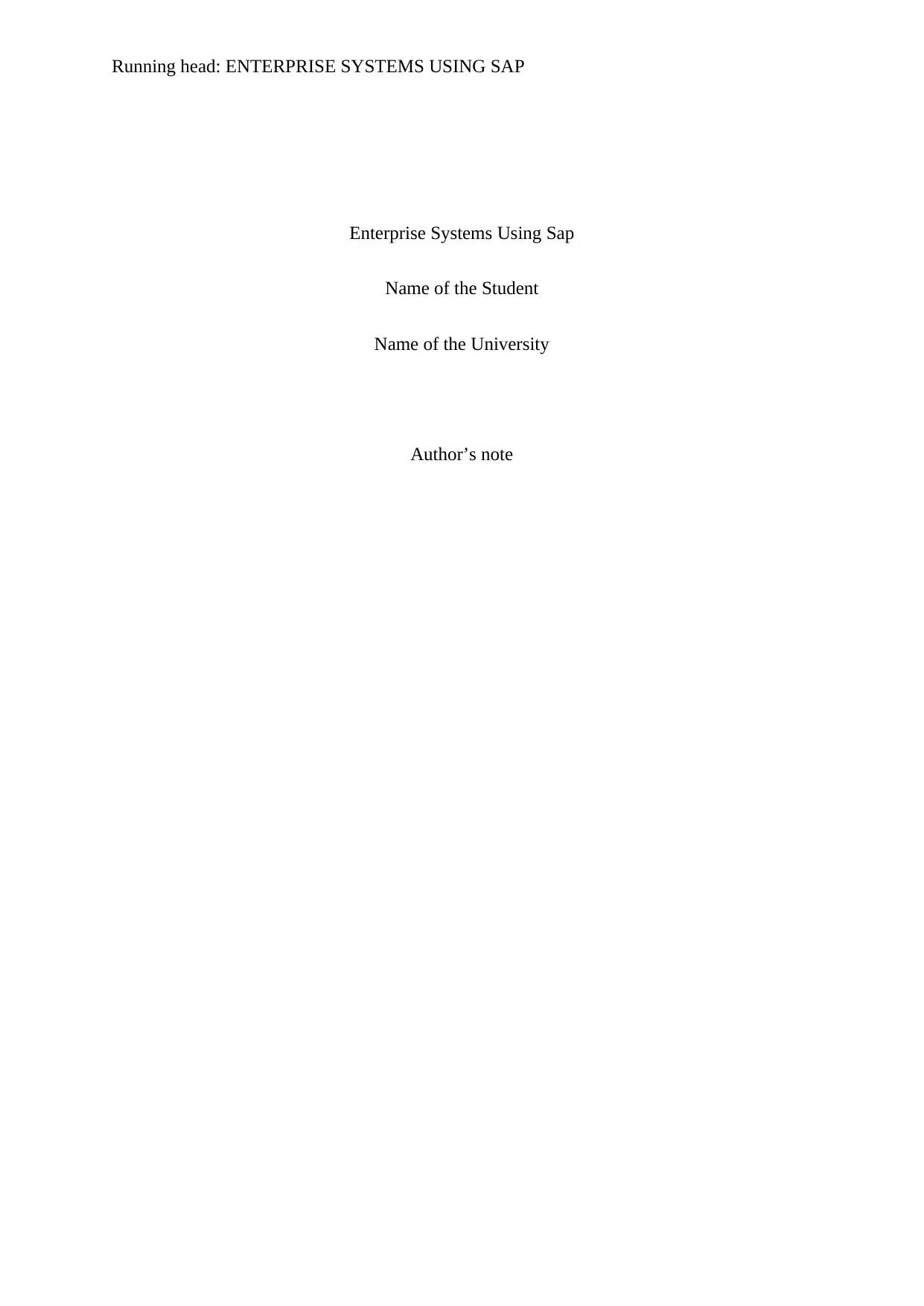
Running head: ENTERPRISE SYSTEMS USING SAP
Enterprise Systems Using Sap
Name of the Student
Name of the University
Author’s note
Enterprise Systems Using Sap
Name of the Student
Name of the University
Author’s note
Paraphrase This Document
Need a fresh take? Get an instant paraphrase of this document with our AI Paraphraser
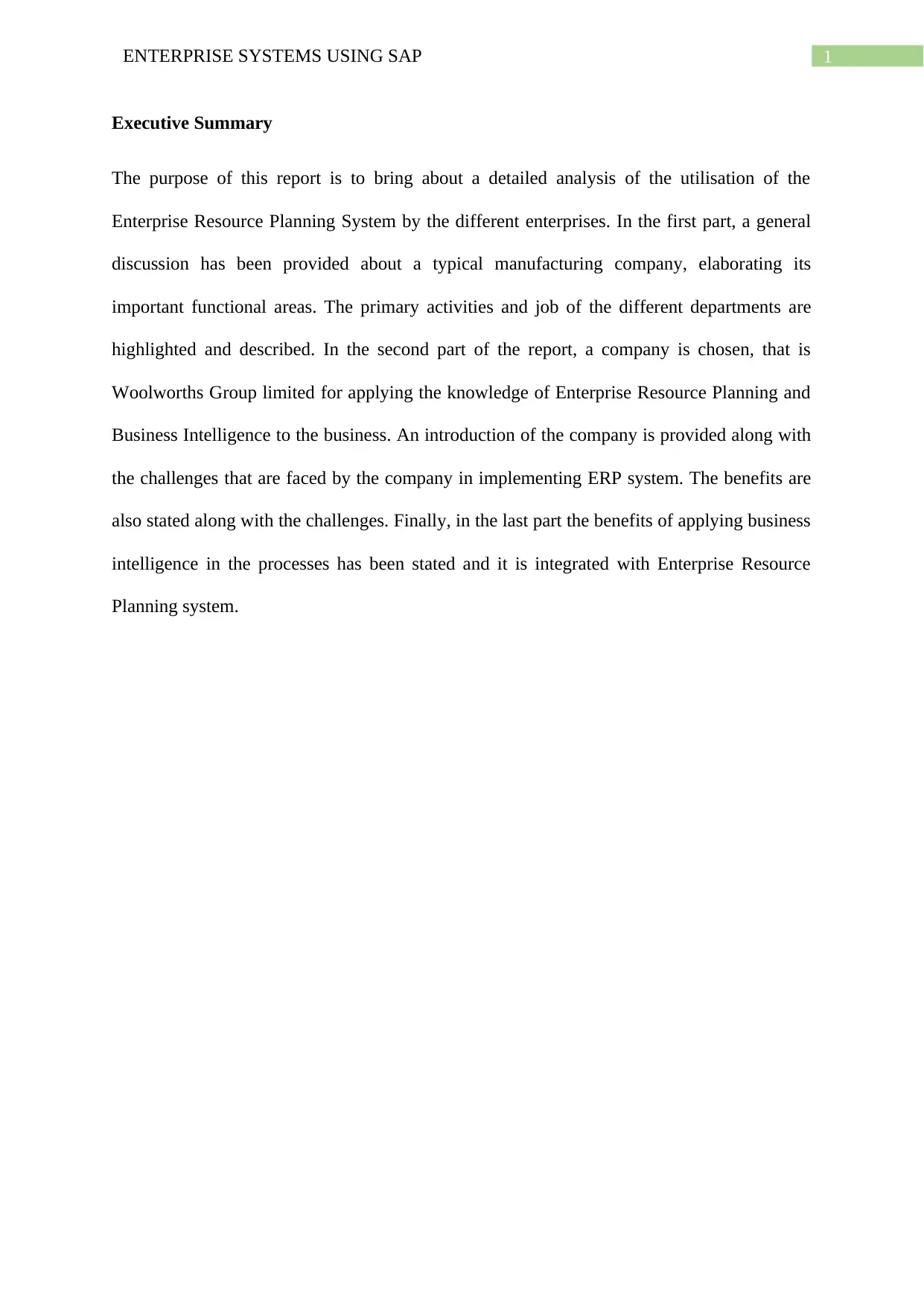
1ENTERPRISE SYSTEMS USING SAP
Executive Summary
The purpose of this report is to bring about a detailed analysis of the utilisation of the
Enterprise Resource Planning System by the different enterprises. In the first part, a general
discussion has been provided about a typical manufacturing company, elaborating its
important functional areas. The primary activities and job of the different departments are
highlighted and described. In the second part of the report, a company is chosen, that is
Woolworths Group limited for applying the knowledge of Enterprise Resource Planning and
Business Intelligence to the business. An introduction of the company is provided along with
the challenges that are faced by the company in implementing ERP system. The benefits are
also stated along with the challenges. Finally, in the last part the benefits of applying business
intelligence in the processes has been stated and it is integrated with Enterprise Resource
Planning system.
Executive Summary
The purpose of this report is to bring about a detailed analysis of the utilisation of the
Enterprise Resource Planning System by the different enterprises. In the first part, a general
discussion has been provided about a typical manufacturing company, elaborating its
important functional areas. The primary activities and job of the different departments are
highlighted and described. In the second part of the report, a company is chosen, that is
Woolworths Group limited for applying the knowledge of Enterprise Resource Planning and
Business Intelligence to the business. An introduction of the company is provided along with
the challenges that are faced by the company in implementing ERP system. The benefits are
also stated along with the challenges. Finally, in the last part the benefits of applying business
intelligence in the processes has been stated and it is integrated with Enterprise Resource
Planning system.
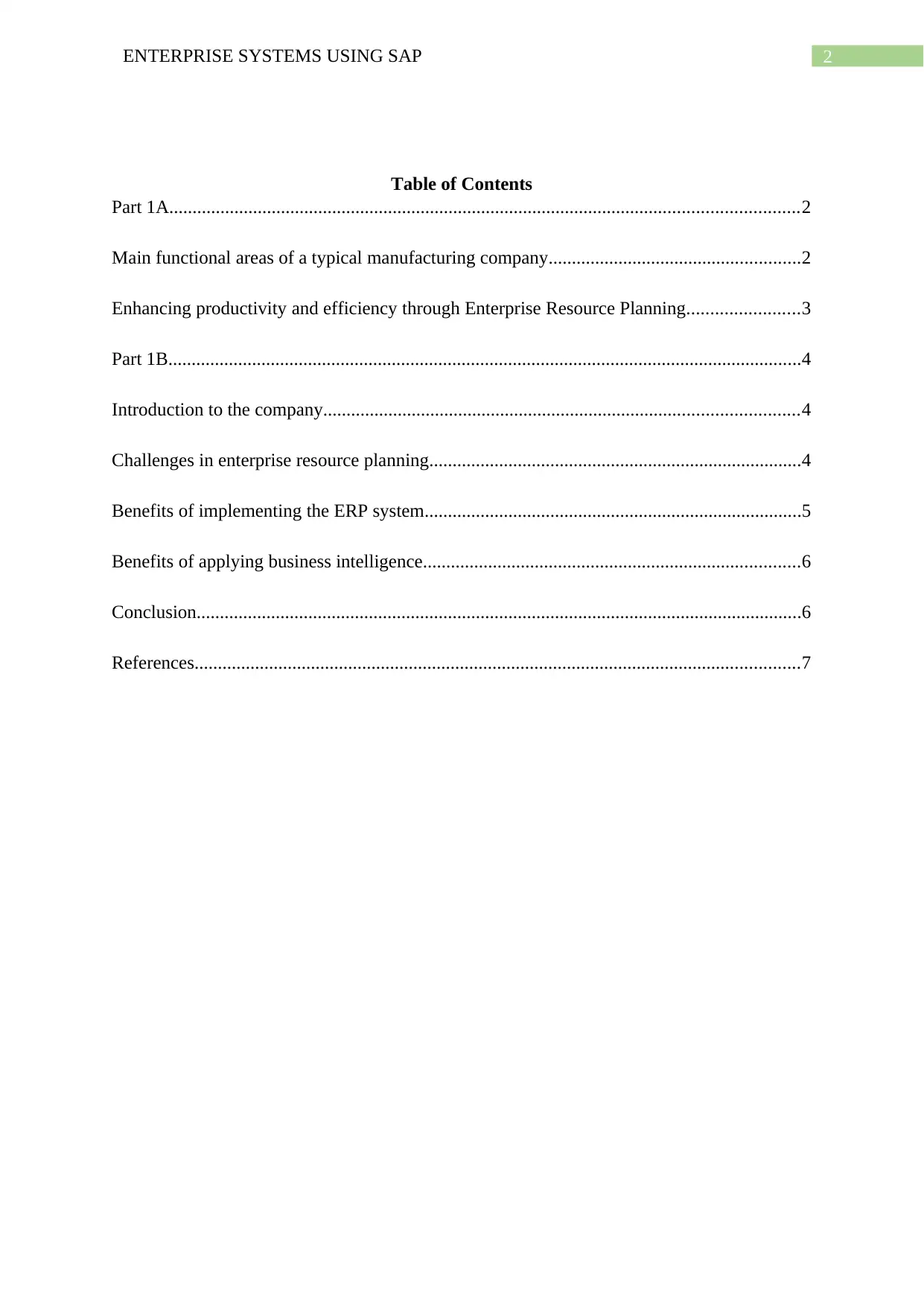
2ENTERPRISE SYSTEMS USING SAP
Table of Contents
Part 1A.......................................................................................................................................2
Main functional areas of a typical manufacturing company......................................................2
Enhancing productivity and efficiency through Enterprise Resource Planning........................3
Part 1B........................................................................................................................................4
Introduction to the company......................................................................................................4
Challenges in enterprise resource planning................................................................................4
Benefits of implementing the ERP system.................................................................................5
Benefits of applying business intelligence.................................................................................6
Conclusion..................................................................................................................................6
References..................................................................................................................................7
Table of Contents
Part 1A.......................................................................................................................................2
Main functional areas of a typical manufacturing company......................................................2
Enhancing productivity and efficiency through Enterprise Resource Planning........................3
Part 1B........................................................................................................................................4
Introduction to the company......................................................................................................4
Challenges in enterprise resource planning................................................................................4
Benefits of implementing the ERP system.................................................................................5
Benefits of applying business intelligence.................................................................................6
Conclusion..................................................................................................................................6
References..................................................................................................................................7
⊘ This is a preview!⊘
Do you want full access?
Subscribe today to unlock all pages.

Trusted by 1+ million students worldwide
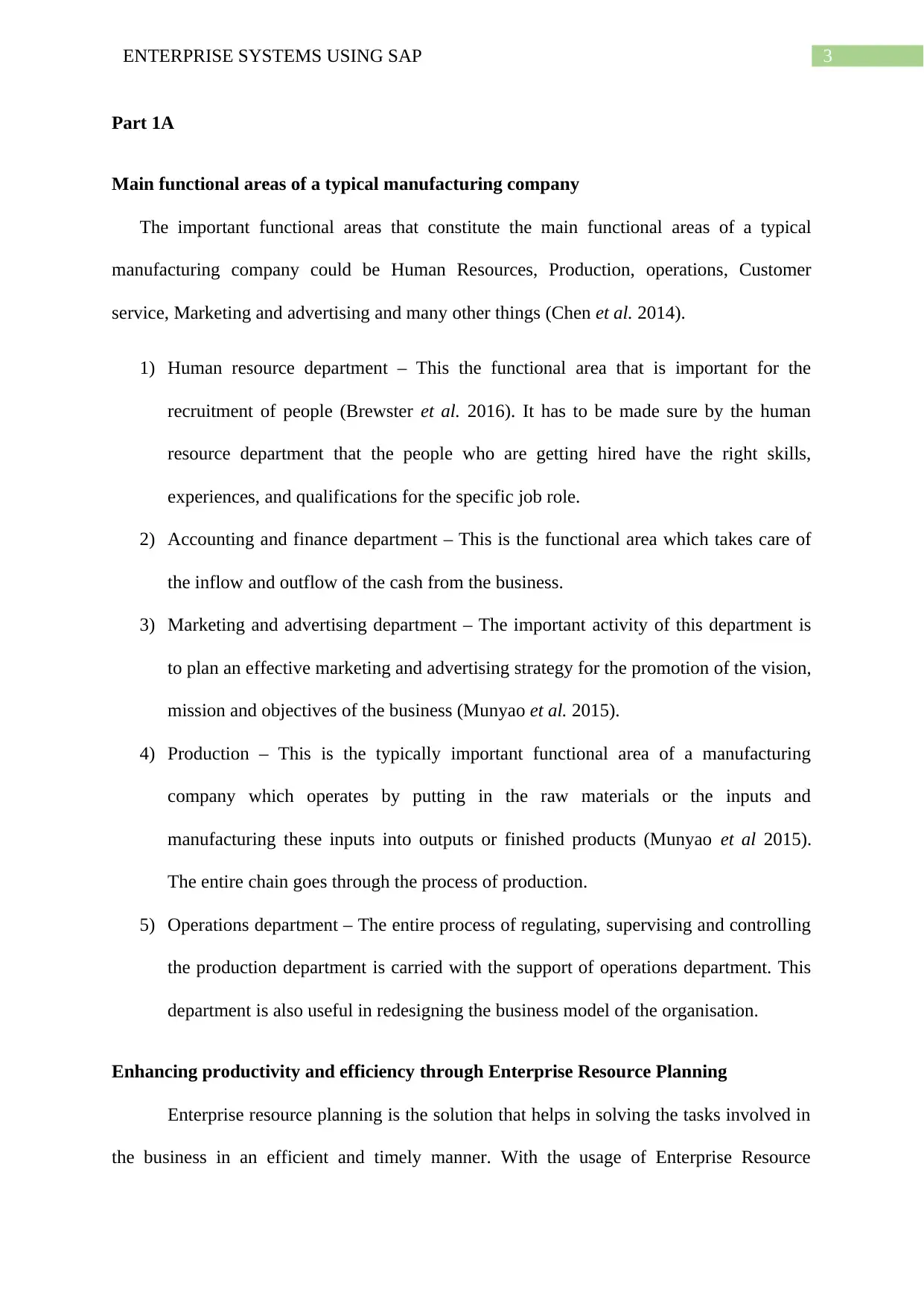
3ENTERPRISE SYSTEMS USING SAP
Part 1A
Main functional areas of a typical manufacturing company
The important functional areas that constitute the main functional areas of a typical
manufacturing company could be Human Resources, Production, operations, Customer
service, Marketing and advertising and many other things (Chen et al. 2014).
1) Human resource department – This the functional area that is important for the
recruitment of people (Brewster et al. 2016). It has to be made sure by the human
resource department that the people who are getting hired have the right skills,
experiences, and qualifications for the specific job role.
2) Accounting and finance department – This is the functional area which takes care of
the inflow and outflow of the cash from the business.
3) Marketing and advertising department – The important activity of this department is
to plan an effective marketing and advertising strategy for the promotion of the vision,
mission and objectives of the business (Munyao et al. 2015).
4) Production – This is the typically important functional area of a manufacturing
company which operates by putting in the raw materials or the inputs and
manufacturing these inputs into outputs or finished products (Munyao et al 2015).
The entire chain goes through the process of production.
5) Operations department – The entire process of regulating, supervising and controlling
the production department is carried with the support of operations department. This
department is also useful in redesigning the business model of the organisation.
Enhancing productivity and efficiency through Enterprise Resource Planning
Enterprise resource planning is the solution that helps in solving the tasks involved in
the business in an efficient and timely manner. With the usage of Enterprise Resource
Part 1A
Main functional areas of a typical manufacturing company
The important functional areas that constitute the main functional areas of a typical
manufacturing company could be Human Resources, Production, operations, Customer
service, Marketing and advertising and many other things (Chen et al. 2014).
1) Human resource department – This the functional area that is important for the
recruitment of people (Brewster et al. 2016). It has to be made sure by the human
resource department that the people who are getting hired have the right skills,
experiences, and qualifications for the specific job role.
2) Accounting and finance department – This is the functional area which takes care of
the inflow and outflow of the cash from the business.
3) Marketing and advertising department – The important activity of this department is
to plan an effective marketing and advertising strategy for the promotion of the vision,
mission and objectives of the business (Munyao et al. 2015).
4) Production – This is the typically important functional area of a manufacturing
company which operates by putting in the raw materials or the inputs and
manufacturing these inputs into outputs or finished products (Munyao et al 2015).
The entire chain goes through the process of production.
5) Operations department – The entire process of regulating, supervising and controlling
the production department is carried with the support of operations department. This
department is also useful in redesigning the business model of the organisation.
Enhancing productivity and efficiency through Enterprise Resource Planning
Enterprise resource planning is the solution that helps in solving the tasks involved in
the business in an efficient and timely manner. With the usage of Enterprise Resource
Paraphrase This Document
Need a fresh take? Get an instant paraphrase of this document with our AI Paraphraser
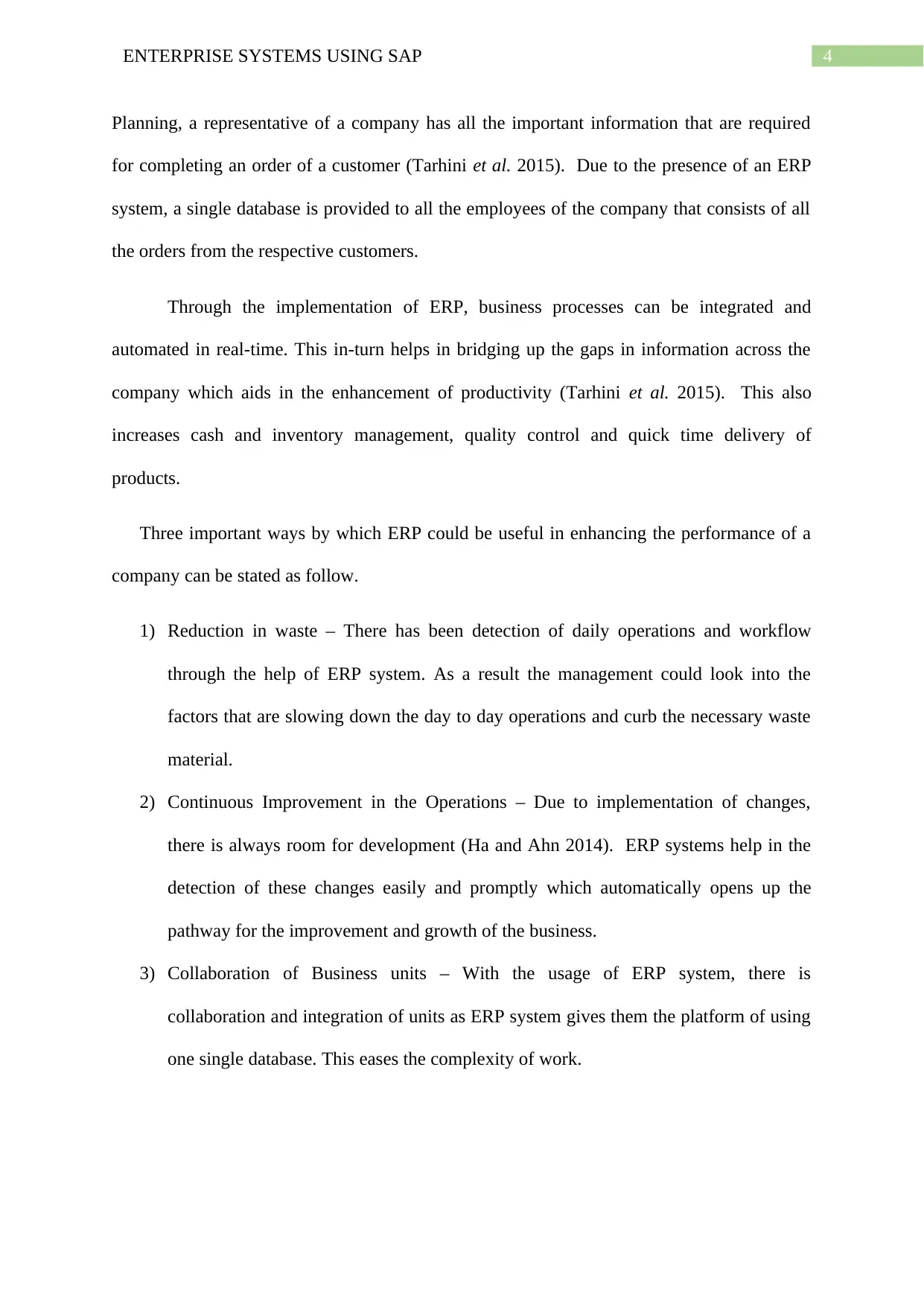
4ENTERPRISE SYSTEMS USING SAP
Planning, a representative of a company has all the important information that are required
for completing an order of a customer (Tarhini et al. 2015). Due to the presence of an ERP
system, a single database is provided to all the employees of the company that consists of all
the orders from the respective customers.
Through the implementation of ERP, business processes can be integrated and
automated in real-time. This in-turn helps in bridging up the gaps in information across the
company which aids in the enhancement of productivity (Tarhini et al. 2015). This also
increases cash and inventory management, quality control and quick time delivery of
products.
Three important ways by which ERP could be useful in enhancing the performance of a
company can be stated as follow.
1) Reduction in waste – There has been detection of daily operations and workflow
through the help of ERP system. As a result the management could look into the
factors that are slowing down the day to day operations and curb the necessary waste
material.
2) Continuous Improvement in the Operations – Due to implementation of changes,
there is always room for development (Ha and Ahn 2014). ERP systems help in the
detection of these changes easily and promptly which automatically opens up the
pathway for the improvement and growth of the business.
3) Collaboration of Business units – With the usage of ERP system, there is
collaboration and integration of units as ERP system gives them the platform of using
one single database. This eases the complexity of work.
Planning, a representative of a company has all the important information that are required
for completing an order of a customer (Tarhini et al. 2015). Due to the presence of an ERP
system, a single database is provided to all the employees of the company that consists of all
the orders from the respective customers.
Through the implementation of ERP, business processes can be integrated and
automated in real-time. This in-turn helps in bridging up the gaps in information across the
company which aids in the enhancement of productivity (Tarhini et al. 2015). This also
increases cash and inventory management, quality control and quick time delivery of
products.
Three important ways by which ERP could be useful in enhancing the performance of a
company can be stated as follow.
1) Reduction in waste – There has been detection of daily operations and workflow
through the help of ERP system. As a result the management could look into the
factors that are slowing down the day to day operations and curb the necessary waste
material.
2) Continuous Improvement in the Operations – Due to implementation of changes,
there is always room for development (Ha and Ahn 2014). ERP systems help in the
detection of these changes easily and promptly which automatically opens up the
pathway for the improvement and growth of the business.
3) Collaboration of Business units – With the usage of ERP system, there is
collaboration and integration of units as ERP system gives them the platform of using
one single database. This eases the complexity of work.
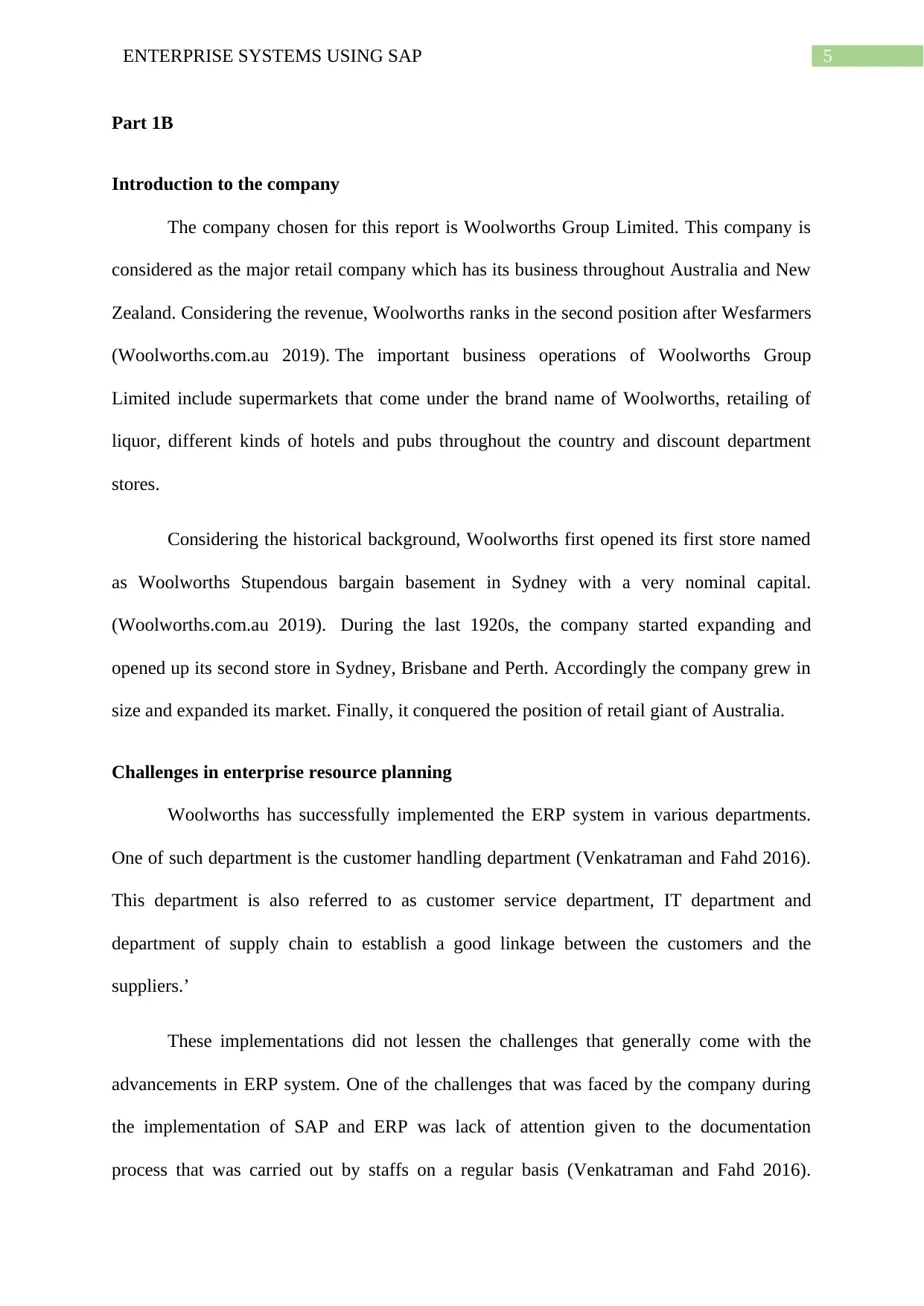
5ENTERPRISE SYSTEMS USING SAP
Part 1B
Introduction to the company
The company chosen for this report is Woolworths Group Limited. This company is
considered as the major retail company which has its business throughout Australia and New
Zealand. Considering the revenue, Woolworths ranks in the second position after Wesfarmers
(Woolworths.com.au 2019). The important business operations of Woolworths Group
Limited include supermarkets that come under the brand name of Woolworths, retailing of
liquor, different kinds of hotels and pubs throughout the country and discount department
stores.
Considering the historical background, Woolworths first opened its first store named
as Woolworths Stupendous bargain basement in Sydney with a very nominal capital.
(Woolworths.com.au 2019). During the last 1920s, the company started expanding and
opened up its second store in Sydney, Brisbane and Perth. Accordingly the company grew in
size and expanded its market. Finally, it conquered the position of retail giant of Australia.
Challenges in enterprise resource planning
Woolworths has successfully implemented the ERP system in various departments.
One of such department is the customer handling department (Venkatraman and Fahd 2016).
This department is also referred to as customer service department, IT department and
department of supply chain to establish a good linkage between the customers and the
suppliers.’
These implementations did not lessen the challenges that generally come with the
advancements in ERP system. One of the challenges that was faced by the company during
the implementation of SAP and ERP was lack of attention given to the documentation
process that was carried out by staffs on a regular basis (Venkatraman and Fahd 2016).
Part 1B
Introduction to the company
The company chosen for this report is Woolworths Group Limited. This company is
considered as the major retail company which has its business throughout Australia and New
Zealand. Considering the revenue, Woolworths ranks in the second position after Wesfarmers
(Woolworths.com.au 2019). The important business operations of Woolworths Group
Limited include supermarkets that come under the brand name of Woolworths, retailing of
liquor, different kinds of hotels and pubs throughout the country and discount department
stores.
Considering the historical background, Woolworths first opened its first store named
as Woolworths Stupendous bargain basement in Sydney with a very nominal capital.
(Woolworths.com.au 2019). During the last 1920s, the company started expanding and
opened up its second store in Sydney, Brisbane and Perth. Accordingly the company grew in
size and expanded its market. Finally, it conquered the position of retail giant of Australia.
Challenges in enterprise resource planning
Woolworths has successfully implemented the ERP system in various departments.
One of such department is the customer handling department (Venkatraman and Fahd 2016).
This department is also referred to as customer service department, IT department and
department of supply chain to establish a good linkage between the customers and the
suppliers.’
These implementations did not lessen the challenges that generally come with the
advancements in ERP system. One of the challenges that was faced by the company during
the implementation of SAP and ERP was lack of attention given to the documentation
process that was carried out by staffs on a regular basis (Venkatraman and Fahd 2016).
⊘ This is a preview!⊘
Do you want full access?
Subscribe today to unlock all pages.

Trusted by 1+ million students worldwide
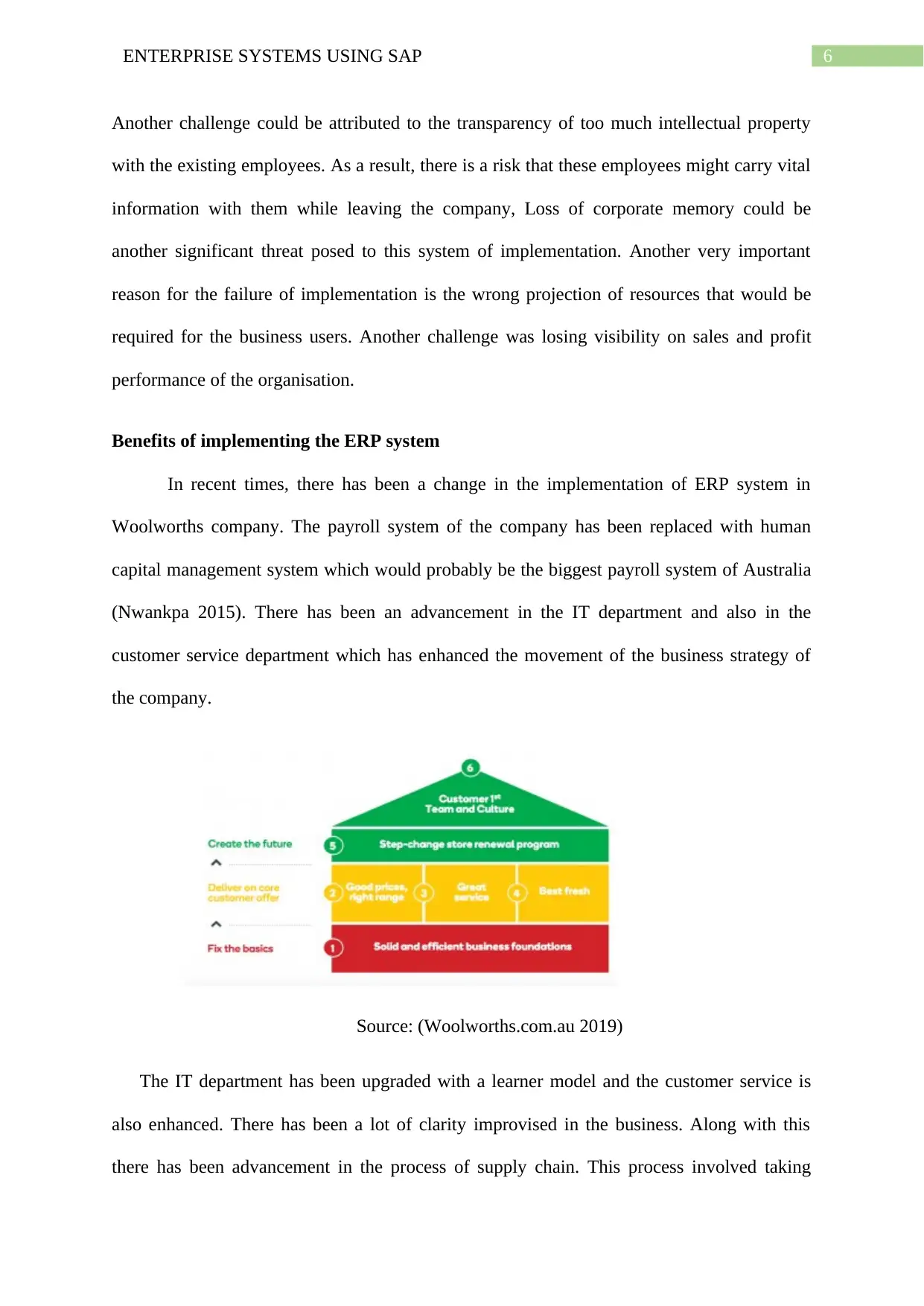
6ENTERPRISE SYSTEMS USING SAP
Another challenge could be attributed to the transparency of too much intellectual property
with the existing employees. As a result, there is a risk that these employees might carry vital
information with them while leaving the company, Loss of corporate memory could be
another significant threat posed to this system of implementation. Another very important
reason for the failure of implementation is the wrong projection of resources that would be
required for the business users. Another challenge was losing visibility on sales and profit
performance of the organisation.
Benefits of implementing the ERP system
In recent times, there has been a change in the implementation of ERP system in
Woolworths company. The payroll system of the company has been replaced with human
capital management system which would probably be the biggest payroll system of Australia
(Nwankpa 2015). There has been an advancement in the IT department and also in the
customer service department which has enhanced the movement of the business strategy of
the company.
Source: (Woolworths.com.au 2019)
The IT department has been upgraded with a learner model and the customer service is
also enhanced. There has been a lot of clarity improvised in the business. Along with this
there has been advancement in the process of supply chain. This process involved taking
Another challenge could be attributed to the transparency of too much intellectual property
with the existing employees. As a result, there is a risk that these employees might carry vital
information with them while leaving the company, Loss of corporate memory could be
another significant threat posed to this system of implementation. Another very important
reason for the failure of implementation is the wrong projection of resources that would be
required for the business users. Another challenge was losing visibility on sales and profit
performance of the organisation.
Benefits of implementing the ERP system
In recent times, there has been a change in the implementation of ERP system in
Woolworths company. The payroll system of the company has been replaced with human
capital management system which would probably be the biggest payroll system of Australia
(Nwankpa 2015). There has been an advancement in the IT department and also in the
customer service department which has enhanced the movement of the business strategy of
the company.
Source: (Woolworths.com.au 2019)
The IT department has been upgraded with a learner model and the customer service is
also enhanced. There has been a lot of clarity improvised in the business. Along with this
there has been advancement in the process of supply chain. This process involved taking
Paraphrase This Document
Need a fresh take? Get an instant paraphrase of this document with our AI Paraphraser
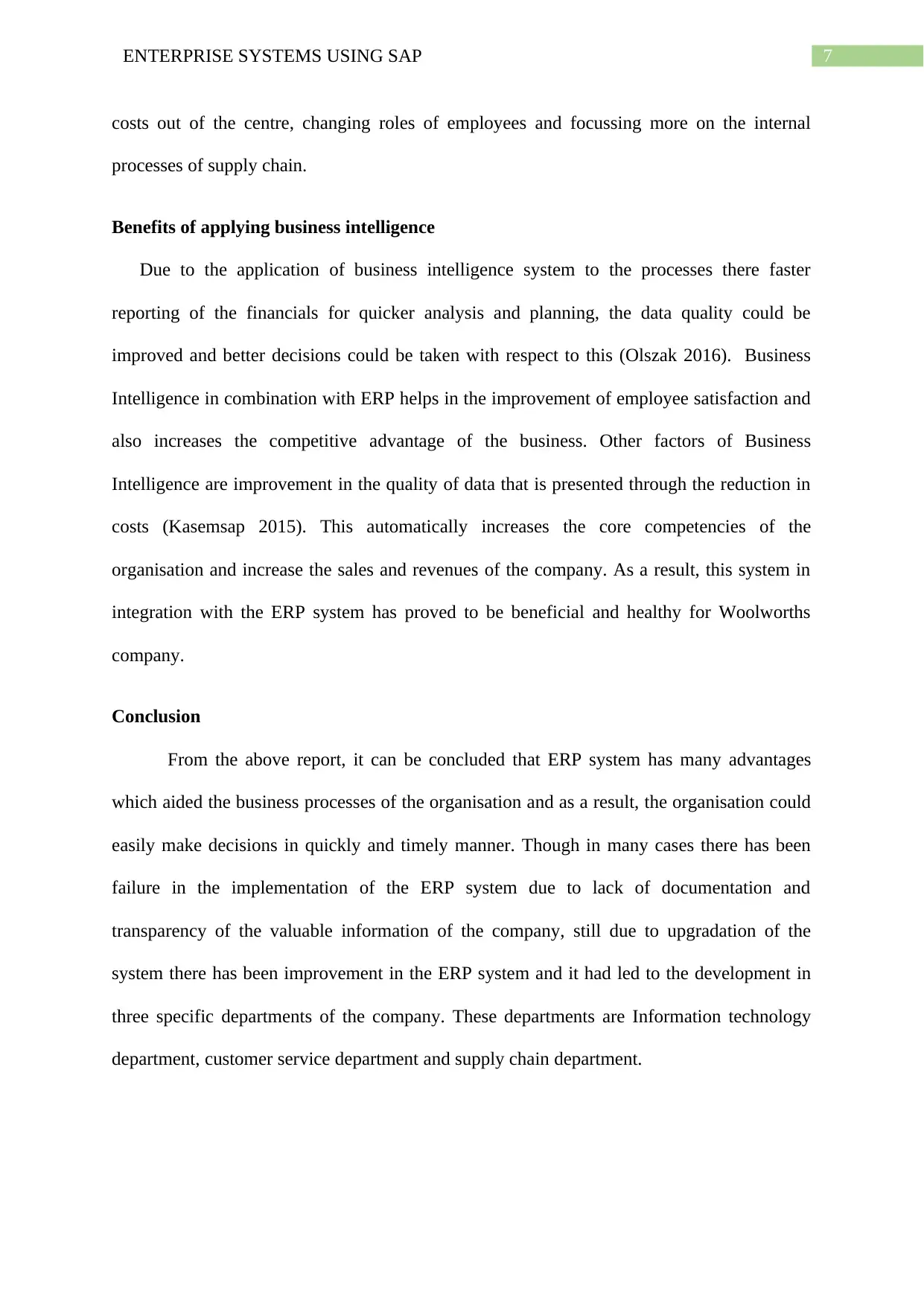
7ENTERPRISE SYSTEMS USING SAP
costs out of the centre, changing roles of employees and focussing more on the internal
processes of supply chain.
Benefits of applying business intelligence
Due to the application of business intelligence system to the processes there faster
reporting of the financials for quicker analysis and planning, the data quality could be
improved and better decisions could be taken with respect to this (Olszak 2016). Business
Intelligence in combination with ERP helps in the improvement of employee satisfaction and
also increases the competitive advantage of the business. Other factors of Business
Intelligence are improvement in the quality of data that is presented through the reduction in
costs (Kasemsap 2015). This automatically increases the core competencies of the
organisation and increase the sales and revenues of the company. As a result, this system in
integration with the ERP system has proved to be beneficial and healthy for Woolworths
company.
Conclusion
From the above report, it can be concluded that ERP system has many advantages
which aided the business processes of the organisation and as a result, the organisation could
easily make decisions in quickly and timely manner. Though in many cases there has been
failure in the implementation of the ERP system due to lack of documentation and
transparency of the valuable information of the company, still due to upgradation of the
system there has been improvement in the ERP system and it had led to the development in
three specific departments of the company. These departments are Information technology
department, customer service department and supply chain department.
costs out of the centre, changing roles of employees and focussing more on the internal
processes of supply chain.
Benefits of applying business intelligence
Due to the application of business intelligence system to the processes there faster
reporting of the financials for quicker analysis and planning, the data quality could be
improved and better decisions could be taken with respect to this (Olszak 2016). Business
Intelligence in combination with ERP helps in the improvement of employee satisfaction and
also increases the competitive advantage of the business. Other factors of Business
Intelligence are improvement in the quality of data that is presented through the reduction in
costs (Kasemsap 2015). This automatically increases the core competencies of the
organisation and increase the sales and revenues of the company. As a result, this system in
integration with the ERP system has proved to be beneficial and healthy for Woolworths
company.
Conclusion
From the above report, it can be concluded that ERP system has many advantages
which aided the business processes of the organisation and as a result, the organisation could
easily make decisions in quickly and timely manner. Though in many cases there has been
failure in the implementation of the ERP system due to lack of documentation and
transparency of the valuable information of the company, still due to upgradation of the
system there has been improvement in the ERP system and it had led to the development in
three specific departments of the company. These departments are Information technology
department, customer service department and supply chain department.
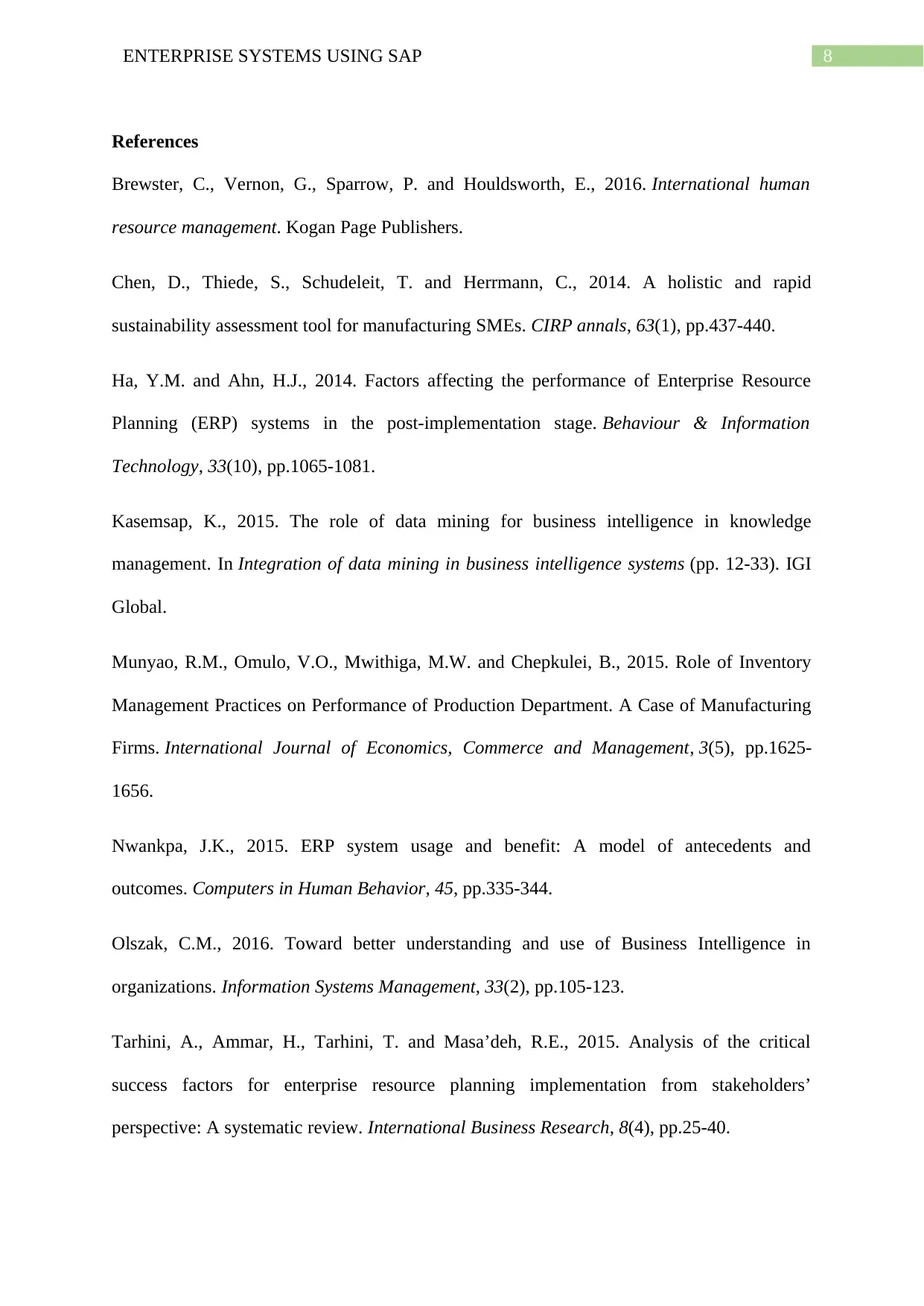
8ENTERPRISE SYSTEMS USING SAP
References
Brewster, C., Vernon, G., Sparrow, P. and Houldsworth, E., 2016. International human
resource management. Kogan Page Publishers.
Chen, D., Thiede, S., Schudeleit, T. and Herrmann, C., 2014. A holistic and rapid
sustainability assessment tool for manufacturing SMEs. CIRP annals, 63(1), pp.437-440.
Ha, Y.M. and Ahn, H.J., 2014. Factors affecting the performance of Enterprise Resource
Planning (ERP) systems in the post-implementation stage. Behaviour & Information
Technology, 33(10), pp.1065-1081.
Kasemsap, K., 2015. The role of data mining for business intelligence in knowledge
management. In Integration of data mining in business intelligence systems (pp. 12-33). IGI
Global.
Munyao, R.M., Omulo, V.O., Mwithiga, M.W. and Chepkulei, B., 2015. Role of Inventory
Management Practices on Performance of Production Department. A Case of Manufacturing
Firms. International Journal of Economics, Commerce and Management, 3(5), pp.1625-
1656.
Nwankpa, J.K., 2015. ERP system usage and benefit: A model of antecedents and
outcomes. Computers in Human Behavior, 45, pp.335-344.
Olszak, C.M., 2016. Toward better understanding and use of Business Intelligence in
organizations. Information Systems Management, 33(2), pp.105-123.
Tarhini, A., Ammar, H., Tarhini, T. and Masa’deh, R.E., 2015. Analysis of the critical
success factors for enterprise resource planning implementation from stakeholders’
perspective: A systematic review. International Business Research, 8(4), pp.25-40.
References
Brewster, C., Vernon, G., Sparrow, P. and Houldsworth, E., 2016. International human
resource management. Kogan Page Publishers.
Chen, D., Thiede, S., Schudeleit, T. and Herrmann, C., 2014. A holistic and rapid
sustainability assessment tool for manufacturing SMEs. CIRP annals, 63(1), pp.437-440.
Ha, Y.M. and Ahn, H.J., 2014. Factors affecting the performance of Enterprise Resource
Planning (ERP) systems in the post-implementation stage. Behaviour & Information
Technology, 33(10), pp.1065-1081.
Kasemsap, K., 2015. The role of data mining for business intelligence in knowledge
management. In Integration of data mining in business intelligence systems (pp. 12-33). IGI
Global.
Munyao, R.M., Omulo, V.O., Mwithiga, M.W. and Chepkulei, B., 2015. Role of Inventory
Management Practices on Performance of Production Department. A Case of Manufacturing
Firms. International Journal of Economics, Commerce and Management, 3(5), pp.1625-
1656.
Nwankpa, J.K., 2015. ERP system usage and benefit: A model of antecedents and
outcomes. Computers in Human Behavior, 45, pp.335-344.
Olszak, C.M., 2016. Toward better understanding and use of Business Intelligence in
organizations. Information Systems Management, 33(2), pp.105-123.
Tarhini, A., Ammar, H., Tarhini, T. and Masa’deh, R.E., 2015. Analysis of the critical
success factors for enterprise resource planning implementation from stakeholders’
perspective: A systematic review. International Business Research, 8(4), pp.25-40.
⊘ This is a preview!⊘
Do you want full access?
Subscribe today to unlock all pages.

Trusted by 1+ million students worldwide
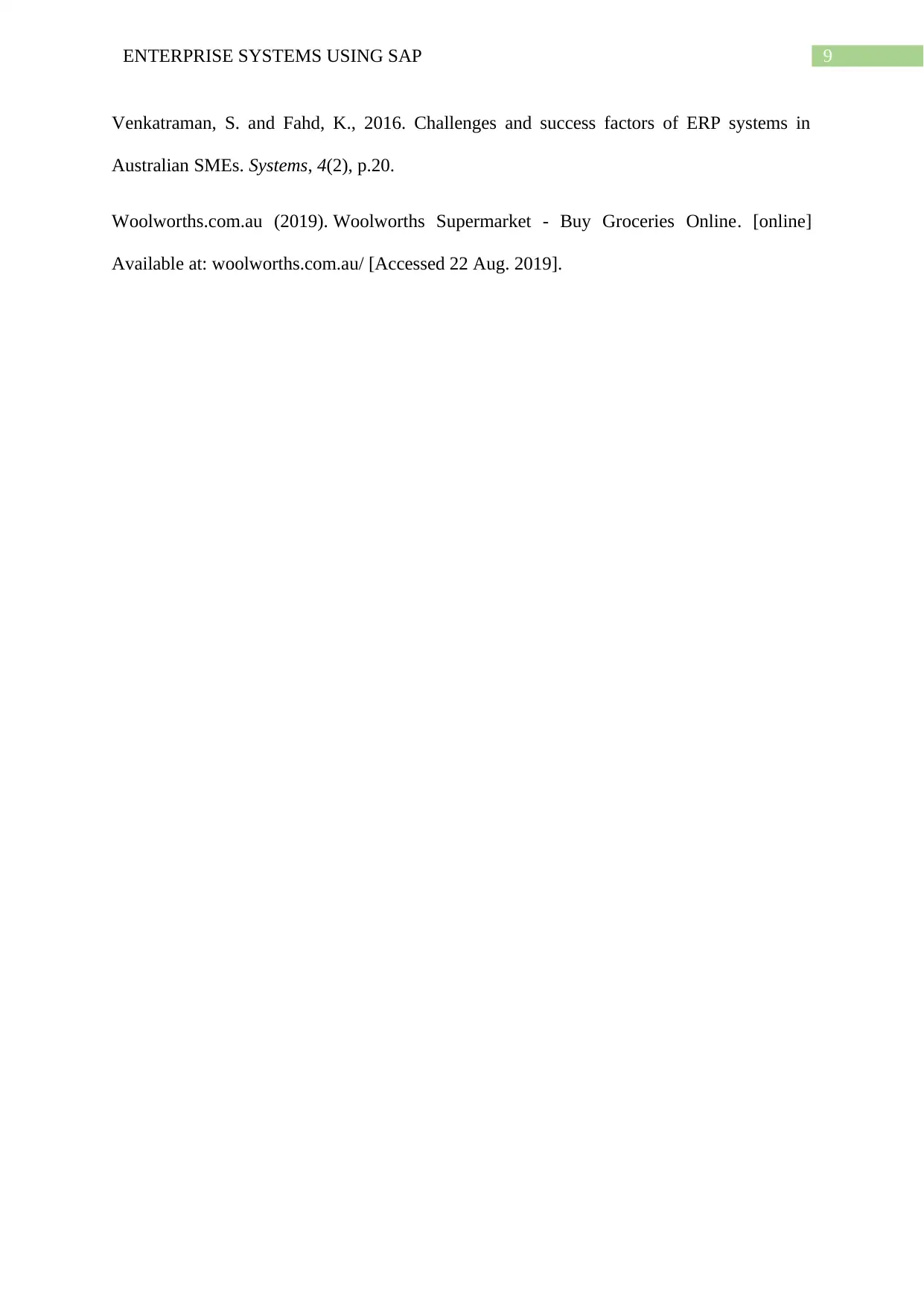
9ENTERPRISE SYSTEMS USING SAP
Venkatraman, S. and Fahd, K., 2016. Challenges and success factors of ERP systems in
Australian SMEs. Systems, 4(2), p.20.
Woolworths.com.au (2019). Woolworths Supermarket - Buy Groceries Online. [online]
Available at: woolworths.com.au/ [Accessed 22 Aug. 2019].
Venkatraman, S. and Fahd, K., 2016. Challenges and success factors of ERP systems in
Australian SMEs. Systems, 4(2), p.20.
Woolworths.com.au (2019). Woolworths Supermarket - Buy Groceries Online. [online]
Available at: woolworths.com.au/ [Accessed 22 Aug. 2019].
1 out of 10
Related Documents
Your All-in-One AI-Powered Toolkit for Academic Success.
+13062052269
info@desklib.com
Available 24*7 on WhatsApp / Email
![[object Object]](/_next/static/media/star-bottom.7253800d.svg)
Unlock your academic potential
Copyright © 2020–2025 A2Z Services. All Rights Reserved. Developed and managed by ZUCOL.





